Toyota Prius
Rear Disc Brake Pads Replacement Guide
How to replace the rear disc brake pads
of a 3rd generation 2010-2015 Toyota Prius hybrid hatchback with pictures.
By Paul B. Michaels Author & Photographer Auto Mechanic Since 1989 |
||
| Please note, I am not a professional auto mechanic. I assume no liability for any damages. Proceed at your own risk. | ||
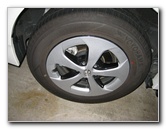 2012 Prius Rear Wheel |
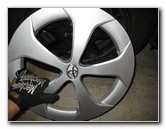 Remove Wheel Cover |
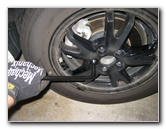 Loosen 5 Lug Nuts |
| This
automotive "how-to" guide was specifically written to assist owners
of the third generation (2010, 2011, 2012, 2013, 2014 & 2015) Toyota Prius in
replacing the rear disc brake pads. Owners of the previous Gen II 2004-2009 Prius vehicles should refer to my Toyota Drum Brake Shoes Replacement Guide. Owners of other Toyota or Lexus cars with rear disc brakes such as the Camry, Sienna, Avalon, Highlander, RAV4, FJ Cruiser, Venza, 4Runner, Sequoia, Tundra, IS250, ES350 may also find these DIY rear brake job instructions to be helpful. The tools needed to complete this procedure include a 10mm socket or wrench, a floor jack, jack stands, a tire iron, a 14mm socket with ratcheting wrench, a thin 17mm cone spanner wrench (jam nut wrench), a "C" or "F" clamp, a brake caliper piston tool (Lisle # 28600) and a new set of rear brake pads. A few compatible aftermarket rear brake pads include the following with their part numbers: Wagner ThermoQuiet QC1423, Akebono ACT1354, Bosch BC1354, Toyota 04466-47080, Raybestos SGD1354C and Monroe CX1423. |
||
|
|
||
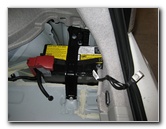 12V Battery Disconnected |
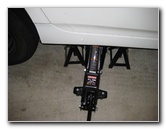 Raise Rear of Vehicle |
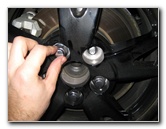 Spin Off Five Lug Nuts |
| The first two steps
are to make sure the vehicle is in "Park" and chock the front wheels with
blocks to prevent it from moving. Regenerative braking occurs on the front wheels only, which is why the 12V battery needs to be disconnected when performing a Toyota Prius Front Brake Job. Just to be safe, I disconnected the black "-" battery cable while working on the rear brakes. To disconnect the battery located on the passenger (right) side of the trunk, you'll need a 10mm wrench. Once you re-connect the battery, you will need to reset the clock, radio presets and the auto window up/down features. If you disconnect the 12 volt battery, do not close the tailgate door. The tailgate latch is electrical, not mechanical. So it can not be opened again with the battery disconnected. I'd recommend placing a towel over the latch so that the tailgate door can not be closed. Then pull off the plastic wheel cover and slightly loosen the five lug nuts with the tire iron. Raise the rear of the vehicle with the floor jack and securely support it with at least two jack stands. |
||
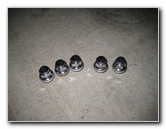 5 Lug Nuts Removed |
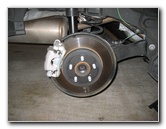 Rear Caliper, Rotor, Bracket |
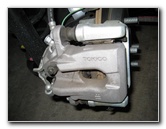 Two 14mm Caliper Bolts |
| Spin off the five
lug nuts in the counter clockwise direction and set them aside in a safe
place.
Remove the wheel to reveal the rear brake caliper, bracket and rotor. |
||
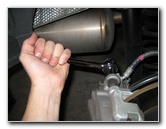 Loosen - Turn Clockwise |
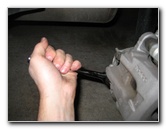 Loosen Lower Caliper Bolt |
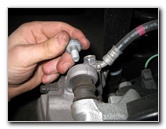 Remove Caliper Bolts |
| Look on the back
side of the brake caliper and locate the upper and lower 14mm caliper bolts. Loosen the twp caliper bolts by turning them clockwise (as seen from the outside of the vehicle) with the 14mm socket and ratcheting wrench. Remove the caliper bolts and set them aside in a safe place. |
||
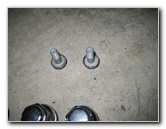 Set Aside In Safe Place |
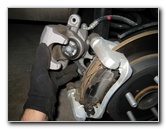 Lift Off Rear Brake Caliper |
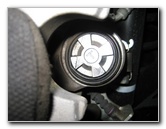 Screw-In Type Rear Piston |
| Carefully lift the rear brake caliper out of the bracket and securely rest it on the suspension or hang it from the spring with some rope. | ||
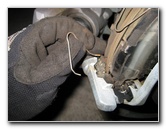 Remove Lower "V" Spring |
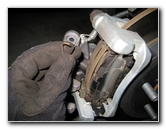 Remove Upper "V" Spring |
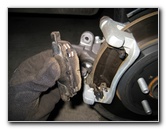 Remove Outer Pad |
| The rear brake pads
are equipped with two "V" springs to keep the pads away from the rotor when
the vehicle is not braking.
Remove the "V" springs and set them aside in a safe place. |
||
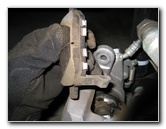 Wear Bar - Bottom Inner Pad |
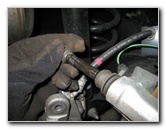 Remove Caliper Slider Pins |
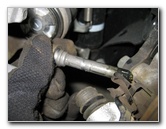 Lubricate & Replace Pins |
| Pull out the old
brake pads and make a mental note of how the wear indicator or "squeal" bar
is situated. On this 2012 Prius, the wear bar was located at the bottom of
the inner pad. I recommend buying the Wagner ThermoQuiet QC1423 rear brake pads since they have excellent reviews on Amazon. In order for the brake caliper to work properly the two caliper slider pins need to be well lubricated with high temperature lubricant. Gently pull the upper and lower caliper pins out of their rubber dust boots and apply some disc brake caliper grease. Push the caliper slider pins back into their rubber dust boots until they snap in place over the lip at the end of the pin. |
||
|
|
||
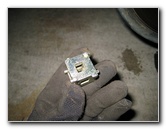 Disc Brake Piston Tool |
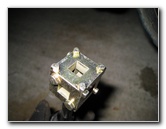 Correct Side - 4 Pegs |
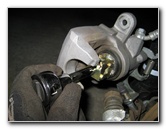 Turn Piston In Clockwise |
| The 3rd generation
Prius has "screw-in" type rear brake caliper pistons that need to be turned
in rather than compressed like traditional pistons. Test fit your disc brake piston tool such as the Lisle 28600 until you find the side that has the best grip on the piston. It should be the side with four "nubs" or "pegs". Attach the brake piston tool to an extension bar and a 3/8" drive ratcheting wrench. Slowly turn the piston clockwise until it retracts into the caliper and becomes flush with its rubber dust boot. Check the level in the brake fluid reservoir as you turn back the piston to be sure that it doesn't overflow. Clean up any spilled brake fluid promptly since it can damage painted surfaces. Thoroughly clean off the brake rotor, caliper bracket, brake caliper assembly and the lug nut studs with brake parts cleaner spray. Do not use compressed air or blow with your mouth to clean off the brake parts since breathing in brake dust can be harmful to your health. Brake dust can be carcinogenic (causes cancer) if inhaled.
To remove the rear brake rotors and install new ones, just remove the two 17mm bolts on the back of the caliper bracket that attach it to the steering knuckle. Then loosen the old rotor with a rubber mallet, pull it off, and slide the new one in its place. |
||
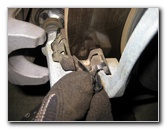 Replace Anti-Rattle Clips |
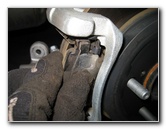 Install New Rear Pads |
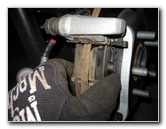 Push Pads Together |
| If your new set of
rear brake pads came with new metal anti-rattle abutment clips, pull the old ones
out of the bracket and install the new clips. If your new pads did not come equipped with brake pad shims (the metal plate on the rear of the old pads), remove the old shims and install them on the new pads. (Unless you bought Wagner ThermoQuiet pads that have built in insulators.) Install the new pads into the bracket with the wear indicator or "squeal" bar situated at the bottom of the inner pad. If your new pads did not come with a wear bar, pull the wear bar off the old inner brake pad and install it at the bottom of the new inner pad. |
||
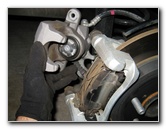 Replace Both "V" Springs |
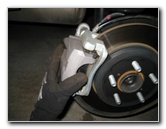 Replace Brake Caliper |
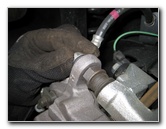 Thread In Caliper Bolt |
| Replace the two "V"
springs at the top and bottom of the new pads. Carefully lower the brake caliper over the new pads and into the bracket. |
||
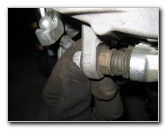 Insert Lower Caliper Bolt |
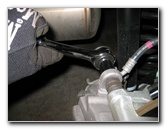 Tighten 14mm Caliper Bolts |
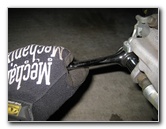 Turn Counter Clockwise |
| Line up the bolt
holes in the caliper with the corresponding bolt holes in the bracket. Insert the two caliper bolts and thread them in a few turns by hand to prevent them from becoming cross threaded. Tighten the caliper bolts with the 14mm socket and ratcheting wrench to just past hand tight or about 25 ft lbs of torque. |
||
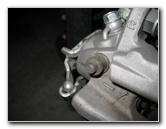 Brake Fluid Bleeder Valve |
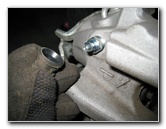 Toyota Scan Tool Required |
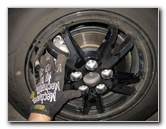 Replace Wheel & Lug Nuts |
| (If you'd like to
properly bleed your brake fluid, it would be best to use a
Toyota Scan Tool connected
to the OBD-II (DLC3)port in order to cycle the ABS solenoid valves.) Double check that the two caliper bolts are tight before continuing on to the next steps. Replace the rear wheel and spin on the five lug nuts by hand to prevent them from becoming cross threaded. |
||
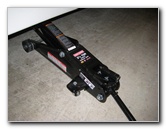 Lower Vehicle From Stands |
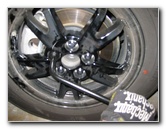 Tighten Lug Nuts |
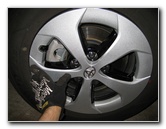 Replace Plastic Hub Cap |
| Lower the vehicle
from the jack stands using the floor jack until the tire holds enough weight
to keep it from spinning. Progressively tighten the lug nuts in a "criss-cross" or "star" pattern with the tire iron to 1/4-1/2 turn past hand tight. It would be best to use a torque wrench or an electric impact wrench with a torque stick to tighten the lug nuts to about 75-100 ft lbs of torque. |
||
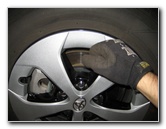 Secure Wheel Cover |
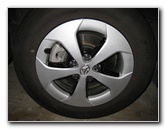 Rear Brake Job Complete |
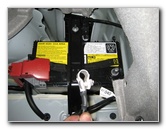 Re-Connect 12V Battery |
|
Line up the plastic wheel cover with the valve stem going through the notch and push it in to place. Firmly tap the hub cap with your fist all around the edge to be sure it is seated properly on the wheel. Sit in the driver's seat of the vehicle and pump the brake pedal a few times to restore brake line pressure. Check the brake fluid in the reservoir and verify that it is at the proper level. If the level is low, pour in some new DOT 3 fluid. Replace the reservoir cap if you haven't already. (If you disconnected the 12V battery, replace the black "-" cable and tighten it with the 10mm wrench. You'll then need to reset the clock, radio presets and the power window auto up/down and jam protection features. Reset the auto window features by putting the window halfway down, then all the way up while holding the switch for a few seconds.) To break in your new rear brake pads, just drive normally for the first few hundred miles while trying to avoid any hard or "panic" stops which may glaze over the new brake pads and cause them to be noisy and/or not perform as well. It's also a good idea to check your driveway or garage daily for drops of brake fluid which may indicate a leak, check the brake fluid level in the reservoir, and also verify that the lug nuts are still tight. For more,
check out my other
Toyota Prius DIY Repair & Maintenance Guides. |
||
| If you found this guide to be helpful,
please consider making a small donation by clicking on the PayPal.com
"Donate" button located to the right of this paragraph. Thank you!
(Note: I am not a registered charity. Donations are not tax deductible.) |

